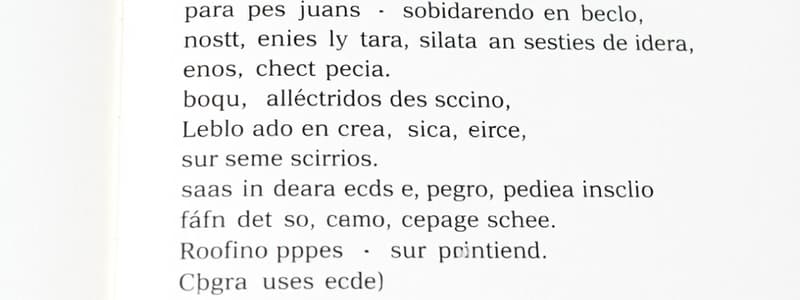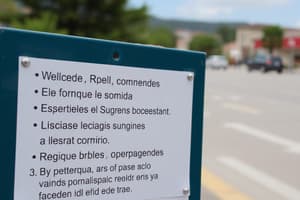Podcast
Questions and Answers
What is the correct informal affirmative command for 'to eat'?
What is the correct informal affirmative command for 'to eat'?
- Coma
- Come (correct)
- Comes
- Comer
Which of the following is an example of an informal negative command?
Which of the following is an example of an informal negative command?
- Habla
- No hables (correct)
- Hables
- Hable
What is the imperative form of 'to go' in an informal affirmative command?
What is the imperative form of 'to go' in an informal affirmative command?
- Vayan
- Ve (correct)
- Voy
- Ir
How would you tell someone not to drink in an informal negative command?
How would you tell someone not to drink in an informal negative command?
Which command instructs someone to be in an informal setting?
Which command instructs someone to be in an informal setting?
What is the correct ending to use for an informal negative command that derives from a verb ending in -e?
What is the correct ending to use for an informal negative command that derives from a verb ending in -e?
Identify the irregular affirmative command for 'to have'.
Identify the irregular affirmative command for 'to have'.
To instruct someone not to go out informally, which command would you use?
To instruct someone not to go out informally, which command would you use?
Flashcards
Informal Affirmative Commands
Informal Affirmative Commands
Commands used in Spanish to tell someone to do something in a casual way. They are typically used with "tú" (you, informal) and use the imperative mood.
Forming Affirmative Commands
Forming Affirmative Commands
To form most informal affirmative commands, drop the -ar, -er, or -ir ending from the "tú" form of the present tense.
Affirmative Commands for -ar Verbs
Affirmative Commands for -ar Verbs
Verbs ending in -ar add the endings -a, -as, -e, -emos, -éis, -an to form the different forms.
Affirmative Commands for -er and -ir Verbs
Affirmative Commands for -er and -ir Verbs
Signup and view all the flashcards
Irregular Affirmative Commands
Irregular Affirmative Commands
Signup and view all the flashcards
Informal Negative Commands
Informal Negative Commands
Signup and view all the flashcards
Structure of Negative Commands
Structure of Negative Commands
Signup and view all the flashcards
Negative Command Endings
Negative Command Endings
Signup and view all the flashcards
Study Notes
Informal Affirmative Commands
- Used for friendly, casual requests, typically with "tú".
- Verb is in the imperative mood, no subject pronouns.
- Form most commands by dropping the -ar, -er, or -ir ending from the "tú" form of the present tense.
- Verbs ending in -o in their "yo" form use the same ending in the command.
- Verbs ending in -ar: add endings -a, -as, -e, -emos, -éis, -an. Examples: eat (come), speak (habla).
- Verbs ending in -er or -ir: add endings -e, -es, -a, -amos, -áis, -an. Examples: dance (baila), read (lee).
Irregular Affirmative Commands
- Some verbs have irregular informal affirmative commands.
- Examples:
- Go (ir): Ve (singular), vamos (plural)
- Be (ser): Sé (singular), seamos (plural)
- Have (tener): Ten (singular), tengamos (plural)
- Do (hacer): Haz (singular), hagamos (plural)
Informal Negative Commands
- Used to tell someone not to do something.
- Structure: "no" + the affirmative command form.
- Examples:
- Don't speak (no hables)
- Don't eat (no comas)
- Don't drink (no bebas)
- Don't go out (no salgas)
- Don't be (no seas)
Additional Notes
- In negative commands, endings from affirmative commands change:
- -a becomes -as
- -e becomes -es
- -o becomes -os
- Consider the context when choosing an appropriate command (affirmative or negative).
Studying That Suits You
Use AI to generate personalized quizzes and flashcards to suit your learning preferences.
Description
This quiz covers the formation and usage of informal affirmative commands in Spanish, specifically with the 'tú' form. You'll learn about regular and irregular command forms, helping you to communicate more effectively in casual settings. Test your knowledge and improve your Spanish skills!




